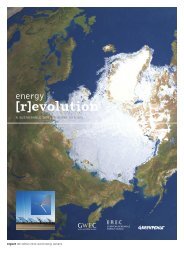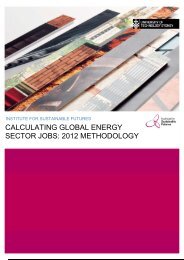download the mexico energy revolution scenario
download the mexico energy revolution scenario
download the mexico energy revolution scenario
You also want an ePaper? Increase the reach of your titles
YUMPU automatically turns print PDFs into web optimized ePapers that Google loves.
2.1 <strong>energy</strong> [r]evolution 2010 – <strong>mexico</strong> <strong>energy</strong> policy brief<br />
legal and institutional context in <strong>the</strong> power sector<br />
legal framework Mexico’s Constitution (Article 27) places sole<br />
responsibility of electricity generation into <strong>the</strong> hands of <strong>the</strong> Federal<br />
state. Moreover, <strong>the</strong> Federal Commission for Electricity (CFE) -<br />
state-owned enterprise and responsible for two-thirds of Mexico’s<br />
<strong>energy</strong> generation and transmission, as well as <strong>the</strong> planning for<br />
<strong>energy</strong> provision-, is bound by this article to provide <strong>energy</strong> at <strong>the</strong><br />
least-cost option. While <strong>the</strong> Ministry of Energy (SENER) could in<br />
<strong>the</strong>ory specify how to interpret this clause, it has in <strong>the</strong> past<br />
adopted a very narrow definition based solely on financial variables.<br />
This has favored <strong>the</strong> development of conventional sources of nonrenewable<br />
<strong>energy</strong>, especially gas and coal, whose use for electricity<br />
generation is expected to rise by 67% and 27% respectively by 2024. 10<br />
The amendment of <strong>the</strong> law on public power supply of 1992 and <strong>the</strong><br />
related regulations confirmed <strong>the</strong> sole right of state enterprises to<br />
supply electricity 11 , i.e. <strong>the</strong> right to transmit and distribute electricity<br />
and to sell electricity to final consumers. The amendments opened new<br />
opportunities for <strong>the</strong> private sector to invest in power generation, in<br />
<strong>the</strong> wake of a substantial decline in public investment in <strong>the</strong> power<br />
sector at <strong>the</strong> end of <strong>the</strong> 1980s. Private enterprises are now able to<br />
engage in <strong>the</strong> following activities: self supply, cogeneration of<br />
electricity and heat 12 , operation as small producers (< 30 MW) or as<br />
independent power producers 13 , <strong>the</strong> export and <strong>the</strong> import of electricity<br />
for <strong>the</strong>ir own use. As a result, considerable investment from <strong>the</strong> private<br />
sector has been successfully mobilized in recent years.<br />
government institutions The guidelines on <strong>energy</strong> policy and future<br />
strategies as well as projections for <strong>the</strong> power sector are drawn up by<br />
<strong>the</strong> Ministry of Energy (Secretaría de Energía – SENER), while <strong>the</strong><br />
Ministry of Finance (Secretaría de Hacienda y Crédito Público)<br />
oversees tariff policy. All plans to expand CFE’s supply capacity must<br />
be approved by <strong>the</strong> Ministry of Energy. It can issue directives for calls<br />
to tender to include independent power producers. Power purchase<br />
agreements concluded in <strong>the</strong> course of tendering procedures are for<br />
terms of 20 to 25 years. All electricity generating facilities belonging<br />
to self-suppliers and Independent Power Producers (IPPs) must be<br />
approved by <strong>the</strong> Energy Regulatory Commission (Comisión<br />
Reguladora de Energía – CRE), which is subordinated to <strong>the</strong> Energy<br />
Ministry and is also responsible for <strong>the</strong> regulation of <strong>the</strong> gas sector. 14<br />
By May of 2010 CRE had granted 684 power generation licenses all<br />
in all, covering a total of 24,017 MW. 15 Of <strong>the</strong>se, 670 plants (almost<br />
98%) were in operation, with a total capacity of 19,144 MW. Most<br />
of <strong>the</strong> 2% left entitled wind <strong>energy</strong> projects.<br />
The institutions involved in <strong>energy</strong> conservation or efficiency efforts are<br />
<strong>the</strong> National Commission for <strong>the</strong> Efficient Use of <strong>the</strong> Energy 16 (Conuee)<br />
and CFE through <strong>the</strong> Trust Fund for Electricity Savings (FIDE).<br />
market actors<br />
state-owned power utility (CFE) Since nationalization in 1960,<br />
almost <strong>the</strong> entire power sector in Mexico has been dominated by<br />
<strong>the</strong> state providers Comisión Federal de Electricidad (CFE), which<br />
currently has some 33.9 million customers (2010). CFE ei<strong>the</strong>r own<br />
<strong>the</strong> power stations itself or conclude longer-term power purchase<br />
image A WORKER ASSEMBLES WIND<br />
TURBINE ROTORS AT GANSU JINFENG<br />
WIND POWER EQUIPMENT CO. LTD. IN<br />
JIUQUAN, GANSU PROVINCE, CHINA.<br />
agreements with private operators CFE meets approximately 67%<br />
of aggregate national power demand. 17 By May 2010 CFE had a<br />
capacity of 51,121 MW (including IPPs). 18<br />
independent power producers By August 2010 <strong>the</strong>re were<br />
already 71 power stations being operated by IPPs. 19 Output and<br />
power generation by self-generators and independent producers in<br />
2009 accounted for almost 33% of <strong>the</strong> figures quoted by CFE,<br />
underlining <strong>the</strong> importance of this sector for <strong>the</strong> Mexican electricity<br />
supply industry.<br />
small producers Small producers are defined by <strong>the</strong> electricity law<br />
as projects with a capacity of less than 30 MW whose electricity is<br />
sold to <strong>the</strong> public utilities. A small producer could generate<br />
electricity without needing to win a bid, and it would <strong>the</strong>n be paid a<br />
percentage of <strong>the</strong> short term marginal cost of <strong>the</strong> <strong>energy</strong>, but no<br />
capacity payment. There is no small producer operating in Mexico.<br />
self-suppliers Besides CFE, which are vertically integrated, and <strong>the</strong><br />
independent power producers, which solely serve <strong>the</strong> purpose of public<br />
supply for CFE, o<strong>the</strong>r actors in <strong>the</strong> Mexican electricity market are<br />
engaged in self-supply projects and for export. Self-suppliers projects<br />
account for almost 7% of total installed capacity. A large proportion<br />
of <strong>the</strong>se self-supply projects are owned and operated by <strong>the</strong> stateowned<br />
oil company Pemex, with about 4% of all electricity<br />
production 20 , and private producers (3%). Industrial, commercial and<br />
municipal self-supply is also permitted. In every case, however, <strong>the</strong><br />
power purchaser (i.e. a municipality, for example) must have at least a<br />
pro forma involvement in <strong>the</strong> company generating <strong>the</strong> power. It is also<br />
possible to make use of <strong>the</strong> public transmission grid if <strong>the</strong> generation<br />
location is some distance away from <strong>the</strong> place of consumption. A<br />
number of enterprises can also found a joint subsidiary for <strong>the</strong><br />
purposes of self-supply. Optionally, any electricity not used for <strong>the</strong><br />
producer’s own purposes at <strong>the</strong> time of generation can be sold to CFE<br />
at 85 % of <strong>the</strong> short-term marginal costs. In recent years <strong>the</strong>re has<br />
been considerable growth in self-supply in <strong>the</strong> service sector.<br />
references<br />
10 ELECTRICITY SECTOR OUTLOOK 2009- 2024 (PERSPECTIVA DEL SECTOR ELÉCTRICO<br />
2009 – 2024). CURRENTLY, GAS REPRESENTS ABOUT 58.5% OF TOTAL GENERATION AND<br />
COAL ABOUT 18%, WHILE 23.5% OF GENERATION ARE PRODUCED BY OIL COMBUSTION.<br />
HTTP://WWW.SENER.GOB.MX/WEBSENER/RES/PE_Y_DT/PUB/PROSPECTIVA%20SE%20200<br />
8-2017.PDF<br />
11 LEY DEL SERVICIO PÚBLICO DE ENERGÍA ELÉCTRICA, DIARIO OFICIAL DE LA<br />
FEDERACIÓN DEL 23 DE DICIEMBRE DE 1992; REGLAMENTO DE LA LEY DEL SERVICIO<br />
PÚBLICO DE ENERGÍA ELÉCTRICA, DIARIO OFICIAL DE LA FEDERACIÓN DEL 31 DE MAYO<br />
DE 1993.<br />
12 COGENERATION OF POWER AND HEAT IS MAINLY EMPLOYED IN THE MEXICAN OIL<br />
INDUSTRY (PEMEX).<br />
13 ONLY PLANTS RATED AT MORE THAN 30 MW WHICH GENERATE POWER SOLELY FOR SALE<br />
TO CFE OR FOR EXPORT ARE CLASSIFIED AS INDEPENDENT POWER PRODUCERS (IPPS).<br />
14 THE TASKS ARE DEFINED IN THE LEY DE LA COMISIÓN REGULADORA DE ENERGÍA,<br />
OCTOBER 31ST, 1995 (MOST RECENTLY AMENDED VERSION OF JANUARY 23TH, 1998).<br />
15 RESPECTIVELY, IMPORTATION AND EXPORTATION LICENSES ACCOUNT FOR 228 MW<br />
AND 2,780 MW. IN TOTAL, CRE AUTHORIZED A TOTAL OF 27,026 MW. SEE:<br />
HTTP://WWW.CRE.GOB.MX/DOCUMENTO/1565.PDF<br />
16 THE FORMER NATIONAL COMMISSION FOR ENERGY CONSERVATION (CONAE) BECAME<br />
CONUEE AFTER THE LAW OF SUSTAINABLE USE OF ENERGY HAS CAME INTO EFFECT<br />
(NOVEMBER 28TH, 2008).<br />
17 GROSS POWER GENERATION IN 2009 TOTALED 230.64 TWH, INCLUDING SUPPLIES<br />
FORM INDEPENDENT PRODUCERS. SEE:<br />
HTTP://WWW.CFE.GOB.MX/QUIENESSOMOS/QUEESCFE/ESTADISTICAS/PAGINAS/INDICADO<br />
RESDEGENERACI%C3%B3N.ASPX<br />
18 INDEPENDENT POWER PRODUCERS ACCOUNTED FOR 11,457 MW OF THIS. SEE:<br />
HTTP://WWW.CFE.GOB.MX/QUIENESSOMOS/QUEESCFE/ESTADISTICAS/PAGINAS/INDICADO<br />
RESDEGENERACI%C3%B3N.ASPX<br />
19 HTTP://WWW.CFE.GOB.MX/QUIENESSOMOS/QUEESCFE/LISTADOCENTRALESGENERADORAS/<br />
PAGINAS/PRODUCTORESINDEPENDIENTES.ASPX<br />
20 PEMEX ALONE HAS AN INSTALLED POWER STATION CAPACITY OF 2,100 MW.<br />
© GP/MARKEL REDONDO<br />
19<br />
2<br />
implementing <strong>the</strong> <strong>energy</strong> [r]evolution | MEXICO ENERGY POLICY BRIEF



![Energy [R]evolution - European Commission](https://img.yumpu.com/49109324/1/184x260/energy-revolution-european-commission.jpg?quality=85)


![5905 gp [eu rev]csfr4.qxd - Energy [R]evolution](https://img.yumpu.com/42305023/1/184x260/5905-gp-eu-revcsfr4qxd-energy-revolution.jpg?quality=85)


![5905 gp [eu rev]csfr4.qxd - Energy [R]evolution](https://img.yumpu.com/28729264/1/184x260/5905-gp-eu-revcsfr4qxd-energy-revolution.jpg?quality=85)